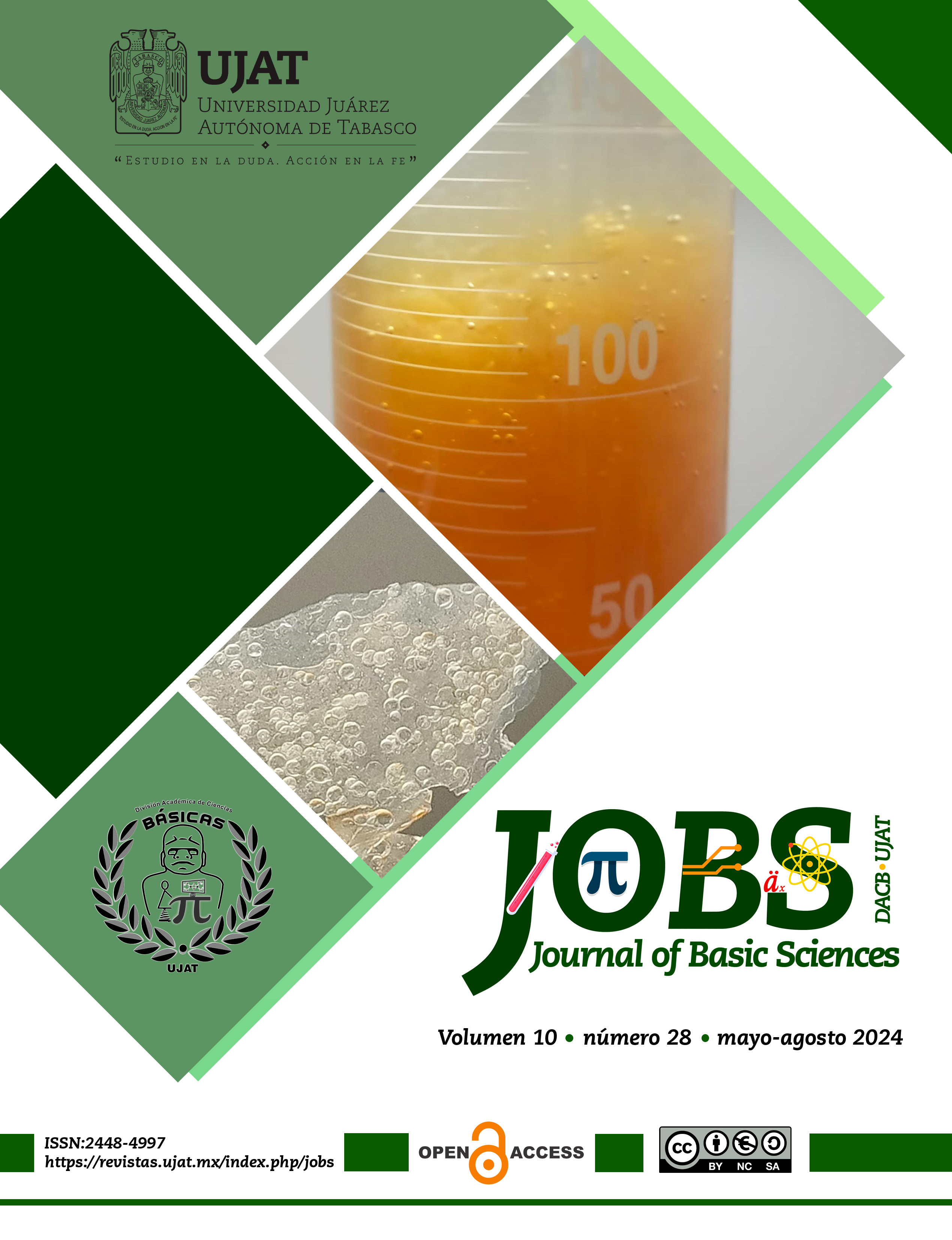Pectin Extracted from Orange Peel (Citrus Sinensis) to Obtain Bioplastic: Synergistic Effects with Alginate
DOI:
https://doi.org/10.19136/jobs.a10n28.6363Keywords:
Bioplastic film, Pectin TGA, Methoxy titrationAbstract
Pectin, derived from agri-food industry waste, is an almost inexhaustible resource. This study aims to develop a bioplastic from pectin extracted from orange peel, combined with commercial alginate, and to investigate its physicochemical and thermal properties. Pectin was extracted using acid hydrolysis, and its degree of esterification and methoxyl content were determined through titration. The bioplastic film was obtained by ionic cross-linking method. Structural characterization was conducted with Fourier Transform Infrared (FTIR) spectroscopy, while the thermal properties of the pectin and the film were assessed via thermogravimetric analysis (TGA). The results indicated that pectin and alginate exhibited synergistic interactions through miscibility and ionic cross-linking. The bioplastic film demonstrated thermal stability, with a plateau in the range of 130 – 200 °C, indicating that the material possesses suitable properties for thermal processing.
References
I. S. Sidek, S. F. S. Draman, S. R. S. Abdullah, and N. Anuar, “Current Development on Bioplastics and Its Future Prospects: an Introductory Review,” INWASCON Technology Magazine, vol. 1, pp. 03–08, 2019, doi: 10.26480/itechmag.01.2019.03.08. DOI: https://doi.org/10.26480/itechmag.01.2019.03.08
G. Bhagwat et al., “Benchmarking Bioplastics: A Natural Step Towards a Sustainable Future,” Journal Polymer Environ, vol. 28, no. 12, pp. 3055–3075, 2020, doi: 10.1007/s10924-020-01830-8. DOI: https://doi.org/10.1007/s10924-020-01830-8
C. Mellinas, M. Ramos, A. Jiménez, and M. C. Garrigós, “Recent trends in the use of pectin from agrowaste residues as a natural based biopolymer for food packaging applications,” Materials, vol. 13, no. 3, 2020, doi: 10.3390/ma13030673. DOI: https://doi.org/10.3390/ma13030673
Li, D. Q., Li, J., Dong, H. L., Li, X., Zhang, J. Q., Ramaswamy, S., and Xu, F. “Pectin in biomedical and drug delivery applications: A review,” International Journal of Biological Macromolecules, vol. 185, no. March, pp. 49–65, 2021, doi: 10.1016/j.ijbiomac.2021.06.088. DOI: https://doi.org/10.1016/j.ijbiomac.2021.06.088
C. Wang, W. Y. Qiu, T. T. Chen, and J. K. Yan, “Effects of structural and conformational characteristics of citrus pectin on its functional properties,” Food Chem, vol. 339, no. September 2020, p. 128064, 2021, doi: 10.1016/j.foodchem.2020.128064. DOI: https://doi.org/10.1016/j.foodchem.2020.128064
Makaremi, M., Yousefi, H., Cavallaro, G., Lazzara, G., Goh, C. B. S., Lee, S. M., ... and Pasbakhsh, P. Safely dissolvable and healable active packaging films based on alginate and pectin. Polymers (Basel), vol. 11, no. 10, pp. 1–18, 2019, doi: 10.3390/polym11101594. DOI: https://doi.org/10.3390/polym11101594
S. S. N. Chakravartula, M. Soccio, N. Lotti, F. Balestra, M. Dalla Rosa, and V. Siracusa, “Characterization of composite edible films based on pectin/alginate/whey protein concentrate,” Materials, vol. 12, no. 15, pp. 1–19, 2019, doi: 10.3390/ma12152454. DOI: https://doi.org/10.3390/ma12152454
M. M. Saldívar Guevara, V. Saucedo-Rivalcoba, J. L. Rivera-Armenta, and L. I. Elvira-Torales, “Evaluation of a Cross-Linking Agent in the Preparation of Films Based on Chitosan and Pectin for Food Packaging Applications,” Cellulose Chemistry and Technology, vol. 56, no. 9–10, pp. 1061–1070, 2022, doi: 10.35812/CelluloseChemTechnol.2022.56.94. DOI: https://doi.org/10.35812/CelluloseChemTechnol.2022.56.94
A. Kumar Tiwari, S. Nath Saha, V. Prasad Yadav, U. Kumar Upadhyay, D. Katiyar, and T. Mishra, “Extraction and Characterization of Pectin from Orange Peels,” International Journal of Biotechnology and Biochemistry, vol. 13, no. 1, pp. 39–47, 2017, [Online]. Available: http://www.ripublication.com
Deng, L. Z., Pan, Z., Zhang, Q., Liu, Z. L., Zhang, Y., Meng, J. S., ... and Xiao, H. W. “Effects of ripening stage on physicochemical properties, drying kinetics, pectin polysaccharides contents and nanostructure of apricots,” Carbohydr Polym, vol. 222, no. February, p. 114980, 2019, doi: 10.1016/j.carbpol.2019.114980. DOI: https://doi.org/10.1016/j.carbpol.2019.114980
Frempong, K. E. B., Chen, Y., Wang, Z., Xu, J., Xu, X., Cui, W., ... and Lin, X. “Study on textural changes and pectin degradation of tarocco blood Orange during storage,” International Journal Food Properties, vol. 25, no. 1, pp. 344–358, 2022, doi: 10.1080/10942912.2022.2032736. DOI: https://doi.org/10.1080/10942912.2022.2032736
E. E. Santos, R. C. Amaro, C. C. C. Bustamante, M. H. A. Guerra, L. C. Soares, and R. E. S. Froes, “Extraction of pectin from agroindustrial residue with an ecofriendly solvent: use of FTIR and chemometrics to differentiate pectins according to degree of methyl esterification,” Food Hydrocoll, vol. 107, no. December 2019, 2020, doi: 10.1016/j.foodhyd.2020.105921. DOI: https://doi.org/10.1016/j.foodhyd.2020.105921
M. A. Patel, M. H. H. AbouGhaly, J. V. Schryer-Praga, and K. Chadwick, “The effect of ionotropic gelation residence time on alginate cross-linking and properties,” Carbohydr Polym, vol. 155, pp. 362–371, 2017, doi: 10.1016/j.carbpol.2016.08.095. DOI: https://doi.org/10.1016/j.carbpol.2016.08.095
Amante, C., Andretto, V., Rosso, A., Augusti, G., Marzocco, S., Lollo, G., and Del Gaudio, P. “Alginate-pectin microparticles loaded with nanoemulsions as nanocomposites for wound healing,” Drug Deliv Transl Res, vol. 13, no. 5, pp. 1343–1357, 2023, doi: 10.1007/s13346-022-01257-9. DOI: https://doi.org/10.1007/s13346-022-01257-9

Downloads
Published
Issue
Section
License
Copyright (c) 2024 Journal of Basic Sciences

This work is licensed under a Creative Commons Attribution-NonCommercial-ShareAlike 4.0 International License.
Usted es libre de:
- Compartir — copiar y redistribuir el material en cualquier medio o formato
- La licenciante no puede revocar estas libertades en tanto usted siga los términos de la licencia
Bajo los siguientes términos:
- Atribución — Usted debe dar crédito de manera adecuada , brindar un enlace a la licencia, e indicar si se han realizado cambios . Puede hacerlo en cualquier forma razonable, pero no de forma tal que sugiera que usted o su uso tienen el apoyo de la licenciante.
- NoComercial — Usted no puede hacer uso del material con propósitos comerciales .
- SinDerivadas — Si remezcla, transforma o crea a partir del material, no podrá distribuir el material modificado.
- No hay restricciones adicionales — No puede aplicar términos legales ni medidas tecnológicas que restrinjan legalmente a otras a hacer cualquier uso permitido por la licencia.
Avisos:
No tiene que cumplir con la licencia para elementos del materiale en el dominio público o cuando su uso esté permitido por una excepción o limitación aplicable.
No se dan garantías. La licencia podría no darle todos los permisos que necesita para el uso que tenga previsto. Por ejemplo, otros derechos como publicidad, privacidad, o derechos morales pueden limitar la forma en que utilice el material.
